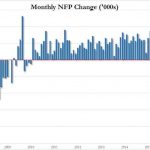In a recent interview I conducted with the legendary market technician Robert Prechter, he offered some very interesting insights into how he views today’s market, along with his perspective on socionomics. He also provides us with a general forecast as to how he sees the market playing out in the coming decade.
1. How did you come across Elliott wave analysis?
My dad subscribed to Richard Russell’s Dow Theory Letters, and he would occasionally forward his copies to me. In 1968, Russell began writing about A.J. Frost’s Elliott wave work. He published wave interpretations for the Dow off and on through late 1974, when he called the end of the bear market. During that time, I began charting gold and gold stocks, labeling the waves. After I became a professional technician at Merrill Lynch in 1975, I went on a search for Elliott’s original books, which were published in ring binders. The Library of Congress didn’t have them. Finally, I found copies on microfilm in the New York Public Library. It was a thrill coming across those listings on library cards. In 1980, I republished Elliott’s original books and articles in what is now called R.N. Elliott’s Masterworks. Later I published all of Bolton’s, Frost’s and Russell’s Elliott wave writings along with bios and notes. In case you know any Elliott wave fanatics who want these books, my staff set up a discount page good through May here.
2a. This question is simply asking for your perspective on how markets have changed – if at all – over the decades in which you have been analyzing Elliott waves.
Markets have changed in superficial ways but not in any essential way. They still trace out Elliott waves. But that doesn’t mean it has been easy. Wave V from 1974 has been unusually large in both price and time relative to waves I and III. The closest thing to it in the record is the 1932-1937 rise, in which wave five lasted 15 times as long as wave one. Also, from 1987 to 2007, pullbacks were shallow and skewed upward in the Dow and S&P, which threw me off.
Some analysts credit the Fed’s inflating for these market attributes. But even as the Fed was expanding the money supply at a record rate, the 2007-2009 drop in the Dow was deeper than one would have expected for wave C of a Primary-degree flat. So, that causal argument is spurious. Here in 2017, even the Dow/PPI is at an all-time high. I chalk it all up to Grand-Supercycle-degree optimism. That’s why we have record credit expansion, too, along with cooperation among members of the Federal Reserve Board and political support for the Fed. All that will change when mood turns negative.
2b. With the advent and proliferation of computer-executed trading, what effect do you feel they have had upon Elliott wave analysis, other than the speed at which trading is now effectuated?
Virtually none. People build their errors of thinking into their programs.
3a. We have analyzed thousands of charts on multiple timeframes and have found a few rules and/or guidelines that MAY be a bit too strict. For example, the rule that states “Waves 1, 2, 3, 4 and 5 of an ending diagonal always subdivide into zigzags” seems to be a bit too stringent as a hard rule, as we believe we have found examples when an Ending Diagonal does not subdivide in this manner. So, are there any plans to update any of the rules within the standard EW structure now that we have decades of further real world example of chart patterns?
An Elliott wave group in Russia asked if diagonals can occasionally have a third wave longer than wave one. The answer is pretty much the same:
I believe it likely that strict rules apply to the inferred Elliott waves of shared mood. But there are no categorical imperatives pertaining to records of the actions people take to express their moods. Market prices are imperfect reflections of market mood, because they record only people’s actions. Waves at small degrees-intraday-are especially imperfect because some individual trading actions can be either forced or impeded by circumstances. Until we can probe people’s brains to record waves of social mood directly, we are stuck with this imperfection. If you read the paragraph on page 86 of Elliott Wave Principle titled “A Summary of Rules and Guidelines for Waves,” you can see that I explicitly stated this point in the book.













Leave A Comment